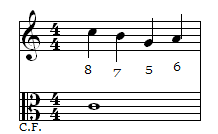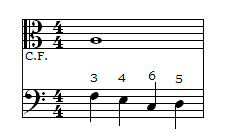
Cambiata
Encyclopedia
Cambiata, or nota cambiata (Italian
for changed note), has a number of different and related meanings. Generally it refers to a pattern in a homophonic
or polyphonic
(and usually contrapuntal
) setting where a note is skipped from in one direction and this is followed by motion in the opposite direction, and where either the note skipped from is distinguished as a dissonance
or the note skipped to is distinguished as a non-harmonic or non-chordal tone
. With regards to pedagogical, species counterpoint, it refers to a more specific set of patterns.
from a dissonance. The dissonant cambiata is frequently called, simply, cambiata, and it is the main focus of cambiata in general. The dissonance in the dissonant cambiata is approached by descending step and occurs on a weak half or quarter of the beat; the skip from the dissonance must be a descending third to a consonance; and this consonance must be followed by some number of ascending steps. This means there are only three possible essential dissonant cambiatas in third species: Two above the cantus firmus
, with vertical intervals 8-7-5-6 (Ex.1) and 6-b5-3-4 (Ex.2); and one below the C.F., with 3-4-6-5 (Ex.3).
The consonant cambiata is not considered an idiom like the dissonant version as it does not break any rules of species counterpoint by itself. There are two consonant cambiatas in third species: One above the C.F., with 6-5-3-4; and one below, with 5-6-8-7. Whereas, when dealing with species counterpoint, the dissonant cambiata is frequently called, simply, cambiata, the consonant cambiata is frequently not noted as cambiata at all.
The inverted cambiata is a cambiata where the melodic movement of the contrapunctus is inverted
; where the dissonant cambiata has a skip down a third, the inverted cambiata has a skip up a third, etc. There are both dissonant and consonant inverted cambiatas. There are three dissonant inverted cambiatas in third species: One above the C.F., with 3-4-6-5; and two below, with 8-7-5-6 and 6-b5-3-4. There are two consonant inverted cambiatas in third species: One above the C.F., with 5-6-8-7; and one below, with 6-5-3-4.
In fifth species, cambiatas need not be quarter-note lines added to whole-note cantus firmi as in these examples, which is only a requirement of the third species, but could take many different rhythmic forms. Rhythmically, it is only essential that the dissonance that is skipped from be in a weak position, when not considering any other rules which may apply. This means further that the cambiatas need not have the same pattern of vertical intervals that the cambiatas in third species have. Example 4 shows a dissonant cambiata in fifth species.
Example 6 shows a cambiata at * as a nonharmonic tone which is skipped to, rather than as a dissonance which is skipped from. It is approached by a skip in one direction and left by step in the opposite direction. The same pattern occurs at (*), and this too may be considered a cambiata, but might not if the chord is considered a major seventh rather than a triad, and so the note would not be nonharmonic.
Italian language
Italian is a Romance language spoken mainly in Europe: Italy, Switzerland, San Marino, Vatican City, by minorities in Malta, Monaco, Croatia, Slovenia, France, Libya, Eritrea, and Somalia, and by immigrant communities in the Americas and Australia...
for changed note), has a number of different and related meanings. Generally it refers to a pattern in a homophonic
Homophony
In music, homophony is a texture in which two or more parts move together in harmony, the relationship between them creating chords. This is distinct from polyphony, in which parts move with rhythmic independence, and monophony, in which all parts move in parallel rhythm and pitch. A homophonic...
or polyphonic
Polyphony
In music, polyphony is a texture consisting of two or more independent melodic voices, as opposed to music with just one voice or music with one dominant melodic voice accompanied by chords ....
(and usually contrapuntal
Counterpoint
In music, counterpoint is the relationship between two or more voices that are independent in contour and rhythm and are harmonically interdependent . It has been most commonly identified in classical music, developing strongly during the Renaissance and in much of the common practice period,...
) setting where a note is skipped from in one direction and this is followed by motion in the opposite direction, and where either the note skipped from is distinguished as a dissonance
Dissonance
Dissonance has several meanings, all related to conflict or incongruity:*Consonance and dissonance in music are properties of an interval or chord*Cognitive dissonance is a state of mental conflict...
or the note skipped to is distinguished as a non-harmonic or non-chordal tone
Nonchord tone
A nonchord tone, nonharmonic tone, or non-harmony note is a note in a piece of music which is not a part of the implied harmony that is described by the other notes sounding at the time...
. With regards to pedagogical, species counterpoint, it refers to a more specific set of patterns.
In species counterpoint
In species counterpoint, the dissonant cambiata can be called an idiom in that it is considered an acceptable pattern even though it breaks a rule, in this case, that of skippingSteps and skips
In music, a step, or conjunct motion, is a linear or successive interval between two pitches which are consecutive scale degrees. Any larger interval is called a skip , or disjunct motion...
from a dissonance. The dissonant cambiata is frequently called, simply, cambiata, and it is the main focus of cambiata in general. The dissonance in the dissonant cambiata is approached by descending step and occurs on a weak half or quarter of the beat; the skip from the dissonance must be a descending third to a consonance; and this consonance must be followed by some number of ascending steps. This means there are only three possible essential dissonant cambiatas in third species: Two above the cantus firmus
Cantus firmus
In music, a cantus firmus is a pre-existing melody forming the basis of a polyphonic composition.The plural of this Latin term is , though the corrupt form canti firmi is also attested...
, with vertical intervals 8-7-5-6 (Ex.1) and 6-b5-3-4 (Ex.2); and one below the C.F., with 3-4-6-5 (Ex.3).
Example 1 ]] |
Example 2 ]] |
Example 3 ]] |
The consonant cambiata is not considered an idiom like the dissonant version as it does not break any rules of species counterpoint by itself. There are two consonant cambiatas in third species: One above the C.F., with 6-5-3-4; and one below, with 5-6-8-7. Whereas, when dealing with species counterpoint, the dissonant cambiata is frequently called, simply, cambiata, the consonant cambiata is frequently not noted as cambiata at all.
The inverted cambiata is a cambiata where the melodic movement of the contrapunctus is inverted
Inversion (music)
In music theory, the word inversion has several meanings. There are inverted chords, inverted melodies, inverted intervals, and inverted voices...
; where the dissonant cambiata has a skip down a third, the inverted cambiata has a skip up a third, etc. There are both dissonant and consonant inverted cambiatas. There are three dissonant inverted cambiatas in third species: One above the C.F., with 3-4-6-5; and two below, with 8-7-5-6 and 6-b5-3-4. There are two consonant inverted cambiatas in third species: One above the C.F., with 5-6-8-7; and one below, with 6-5-3-4.
In fifth species, cambiatas need not be quarter-note lines added to whole-note cantus firmi as in these examples, which is only a requirement of the third species, but could take many different rhythmic forms. Rhythmically, it is only essential that the dissonance that is skipped from be in a weak position, when not considering any other rules which may apply. This means further that the cambiatas need not have the same pattern of vertical intervals that the cambiatas in third species have. Example 4 shows a dissonant cambiata in fifth species.
Example 4 |
Outside species counterpoint
Outside species counterpoint, what is considered a cambiata varies. What is common to all is that a note is skipped from in one direction and this is followed by motion in the opposite direction, and either the note skipped from is distinguished as a dissonance or the note skipped to is distinguished as a non-chordal tone. This means that three aspects of cambiata in species counterpoint—that the note which is skipped from must be preceded by a step, that the skip be a third, and that the note which is skipped to must be followed by a step in the opposite direction of the skip—are not necessarily all true for all patterns which are considered cambiatas. For example, a pattern in two-voice counterpoint, similar to the dissonant or dissonant inverted cambiata in species counterpoint, but which only does not follow the dissonance which is skipped to with a step in the opposite direction, but rather with a skip in the opposite direction, is still called a cambiata. This is shown in Example 5, which is from Guerrero's Ex. 16-15.Example 6 shows a cambiata at * as a nonharmonic tone which is skipped to, rather than as a dissonance which is skipped from. It is approached by a skip in one direction and left by step in the opposite direction. The same pattern occurs at (*), and this too may be considered a cambiata, but might not if the chord is considered a major seventh rather than a triad, and so the note would not be nonharmonic.
Example 5 |
Example 6 |

